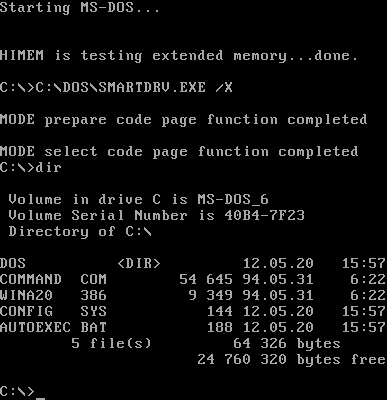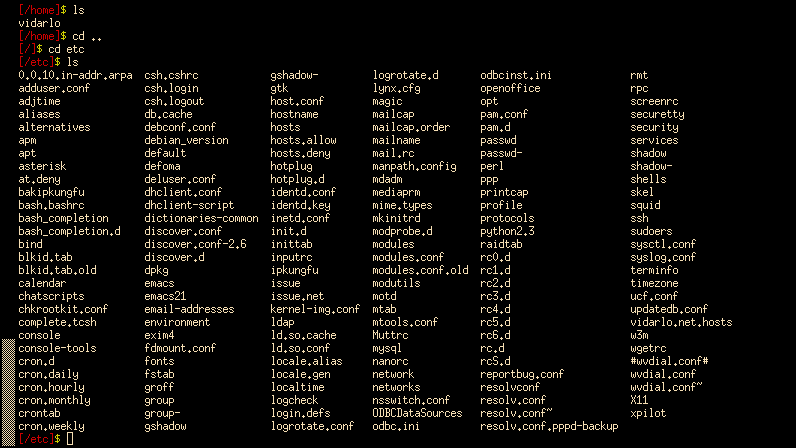|
HyperACCESS
HyperACCESS (sometimes known as HyperTerminal) is a family of terminal emulation software by Hilgraeve. A version of HyperACCESS called HyperTerminal is included in some versions of Windows. History It was the first software product from Hilgraeve, and it was initially designed to let 8-bit Heathkit, Heath computers communicate over a modem. In 1985, this same product was ported to IBM PCs and compatible systems, as well as Heath/Zenith's Zenith Z-100, Z-100 non-PC-compatible MS-DOS computer. Over the years, the same version of this technology would be ported to other operating systems, including OS/2, Windows 95 and Windows NT. It has earned a total of five Editor's Choice awards from ''PC Magazine''. In 1995, Hilgraeve licensed a low-end version of HyperACCESS, known as HyperTerminal, to Microsoft for use in their set of communications utilities. It was bundled with Windows 95 through Windows XP, but is no longer bundled with Windows Vista, Windows 7, Windows 8, or later Win ... [...More Info...] [...Related Items...] OR: [Wikipedia] [Google] [Baidu] |
Hilgraeve
Hilgraeve is a software firm based in Monroe, Michigan, and is best known for its HyperTerminal Private Edition and HyperACCESS programs. In earlier years, HyperTerminal had been licensed for use by Microsoft in versions of Windows ranging from Windows 95 to Windows XP. The company was founded in 1980 by John Hile, Matt Gray, and Bob Everett. The company's name was derived from the first three letters of each of the founder's last names. The firm's first software product was HyperACCESS, which was initially designed to enable Heathkit, Heath 8-bit computers to communicate over a modem. In 1985, this same product was ported to IBM Personal Computer, IBM PCs and compatible systems. Over the years the same version of this technology would be ported to other operating systems including OS/2, Windows 95, Windows XP, and Windows NT. Competition heated up in the early 1990s and Hilgraeve would compete in the online communications software market against the likes of Datastorm Techno ... [...More Info...] [...Related Items...] OR: [Wikipedia] [Google] [Baidu] |
List Of Terminal Emulators
This is a list of notable terminal emulators. Most used terminal emulators on Linux and Unix-like systems are GNOME Terminal on GNOME and GTK-based environments, Konsole on KDE, and xfce4-terminal on Xfce as well as xterm. List See also * Web-based SSH References External links Linux console escape and control sequencesList of X11 terminals available on Gentoo LinuxList of X11 terminals available on archlinuxGuide to Windows terminals The Grumpy Editor's guide to terminal emulators 2004 Comprehensive Linux Terminal Performance Comparison 2007 x11-terminals {{Terminal emulator Terminal emulators, * Lists of software, Emulators, Terminal ... [...More Info...] [...Related Items...] OR: [Wikipedia] [Google] [Baidu] |
Minitel
The Minitel, officially known as TELETEL, was an interactive videotex online service accessible through telephone lines. It was the world's first and most successful mass-market online service prior to the World Wide Web. It was developed in Cesson-Sévigné, Brittany, by government-owned France Télécom. The service was initially launched on an experimental basis on 15 July 1980 in Saint-Malo and extended to other regions in autumn 1980. It was commercially introduced throughout France in 1982 by the PTT (Postes, Télégraphes et Téléphones; since 1991, divided into France Télécom and La Poste (France), La Poste)."Minitel: The rise and fall of the France-wide web" , Hugh Schofield, ''BBC News Magazine'' (Paris), 27 June 2012. From its inception, users were able to make online purcha ... [...More Info...] [...Related Items...] OR: [Wikipedia] [Google] [Baidu] |
DOS Software
DOS (, ) is a family of disk-based operating systems for IBM PC compatible computers. The DOS family primarily consists of IBM PC DOS and a rebranded version, Microsoft's MS-DOS, both of which were introduced in 1981. Later compatible systems from other manufacturers include DR-DOS (1988), ROM-DOS (1989), PTS-DOS (1993), and FreeDOS (1994). MS-DOS dominated the IBM PC compatible market between 1981 and 1995. Although the name has come to be identified specifically with MS-DOS and compatible operating systems, ''DOS'' is a platform-independent acronym for ''disk operating system'', whose use predates the IBM PC. Dozens of other operating systems also use the acronym, beginning with the mainframe DOS/360 from 1966. Others include Apple DOS, Apple ProDOS, Atari DOS, Commodore DOS, TRSDOS, and AmigaDOS. History Origins IBM PC DOS (and the separately sold MS-DOS) and its predecessor, 86-DOS, ran on Intel 8086 16-bit processors. It was developed to be sim ... [...More Info...] [...Related Items...] OR: [Wikipedia] [Google] [Baidu] |
Terminal Emulators
A terminal emulator, or terminal application, is a computer program that emulates a video terminal within some other display architecture. Though typically synonymous with a shell or text terminal, the term ''terminal'' covers all remote terminals, including graphical interfaces. A terminal emulator inside a graphical user interface is often called a terminal window. A terminal window allows the user access to a text terminal and all its applications such as command-line interfaces (CLI) and text user interface (TUI) applications. These may be running either on the same machine or on a different one via telnet, ssh, dial-up, or over a direct serial connection. On Unix-like operating systems, it is common to have one or more terminal windows connected to the local machine. Terminals usually support a set of escape sequences for controlling color, cursor position, etc. Examples include the family of terminal control sequence standards that includes ECMA-48, ANSI X3.64, and ... [...More Info...] [...Related Items...] OR: [Wikipedia] [Google] [Baidu] |
Communication Software
Communication software is used to provide remote access to systems and exchange files and messages in text, audio and/or video formats between different computers or User (computing), users. This includes terminal emulators, file transfer programs, chat and instant messaging programs, as well as similar functionality integrated within Multi-user dungeon, MUDs. The term is also applied to software operating a bulletin board system, but seldom to that operating a computer network or Stored Program Control exchange. History E-mail was introduced in the early 1960's as a way for multiple users of a time-sharing mainframe computer to communicate. Basic text chat functionality has existed on multi-user computer systems and bulletin board systems since the early 1970s. In the 1980s, a terminal emulator was a piece of software necessary to log into Mainframe computer, mainframes and thus access e-mail. Prior to the rise of the Internet, computer files were exchanged over dialup lines, req ... [...More Info...] [...Related Items...] OR: [Wikipedia] [Google] [Baidu] |
YMODEM
YMODEM is a file transfer protocol used between microcomputers connected together using modems. It was primarily used to transfer files to and from bulletin board systems. YMODEM was developed by Chuck Forsberg as an expansion of XMODEM and was first implemented in his CP/M YAM program. Initially also known as YAM, it was formally given the name "YMODEM" in 1985 by Ward Christensen, author of the original XMODEM. YMODEM extended XMODEM in three ways, combining features found in other extended XMODEM varieties. Like XMODEM-CRC, YMODEM replaced the 8-bit checksum with a 16-bit cyclic redundancy check (CRC), but made it the default form of correction instead of optional. From TeLink it added the "block 0" header that sent the filename and size, which allowed batch transfers (multiple files in a single session) and eliminated the need to add padding at the end of the file. Finally, YMODEM allowed the block size to be increased from the original 128 bytes of data to 1024, as in XMOD ... [...More Info...] [...Related Items...] OR: [Wikipedia] [Google] [Baidu] |
XMODEM
XMODEM is a simple file transfer protocol developed as a quick hack by Ward Christensen for use in his 1977 MODEM.ASM terminal program. It allowed users to transmit files between their computers when both sides used MODEM. Keith Petersen made a minor update to always turn on "quiet mode", and called the result XMODEM. XMODEM, like most file transfer protocols, breaks up the original data into a series of " packets" that are sent to the receiver, along with additional information allowing the receiver to determine whether that packet was correctly received. If an error is detected, the receiver requests that the packet be re-sent. A string of bad packets causes the transfer to abort. XMODEM became extremely popular in the early bulletin board system (BBS) market, largely because it was simple to implement. It was also fairly inefficient, and as modem speeds increased, this problem led to the development of a number of modified versions of XMODEM to improve performance or address ... [...More Info...] [...Related Items...] OR: [Wikipedia] [Google] [Baidu] |
Kermit (protocol)
Kermit is a computer file transfer and management protocol and a set of communications software tools primarily used in the early years of personal computing in the 1980s. It provides a consistent approach to file transfer, terminal emulation, script programming, and character set conversion across many different computer hardware and operating system platforms. Technical The Kermit protocol supports text and binary file transfers on both full-duplex and half-duplex 8-bit and 7-bit serial connections in a system- and medium-independent fashion, and is implemented on hundreds of different computer and operating system platforms. On full-duplex connections, a sliding window protocol is used with selective retransmission which provides excellent performance and error recovery characteristics. On 7-bit connections, locking shifts provide efficient transfer of 8-bit data. When properly implemented, as in the Columbia University Kermit Software collection, its authors claim perfor ... [...More Info...] [...Related Items...] OR: [Wikipedia] [Google] [Baidu] |
ASCII
ASCII ( ), an acronym for American Standard Code for Information Interchange, is a character encoding standard for representing a particular set of 95 (English language focused) printable character, printable and 33 control character, control characters a total of 128 code points. The set of available punctuation had significant impact on the syntax of computer languages and text markup. ASCII hugely influenced the design of character sets used by modern computers; for example, the first 128 code points of Unicode are the same as ASCII. ASCII encodes each code-point as a value from 0 to 127 storable as a seven-bit integer. Ninety-five code-points are printable, including digits ''0'' to ''9'', lowercase letters ''a'' to ''z'', uppercase letters ''A'' to ''Z'', and commonly used punctuation symbols. For example, the letter is represented as 105 (decimal). Also, ASCII specifies 33 non-printing control codes which originated with ; most of which are now obsolete. The control cha ... [...More Info...] [...Related Items...] OR: [Wikipedia] [Google] [Baidu] |


